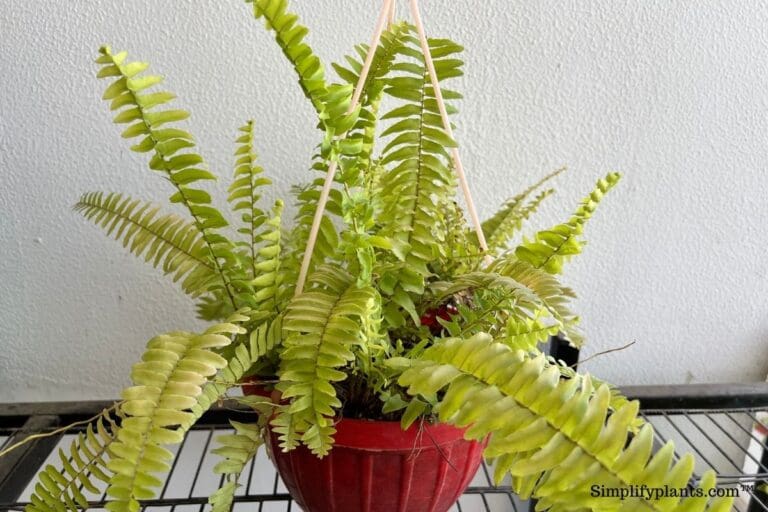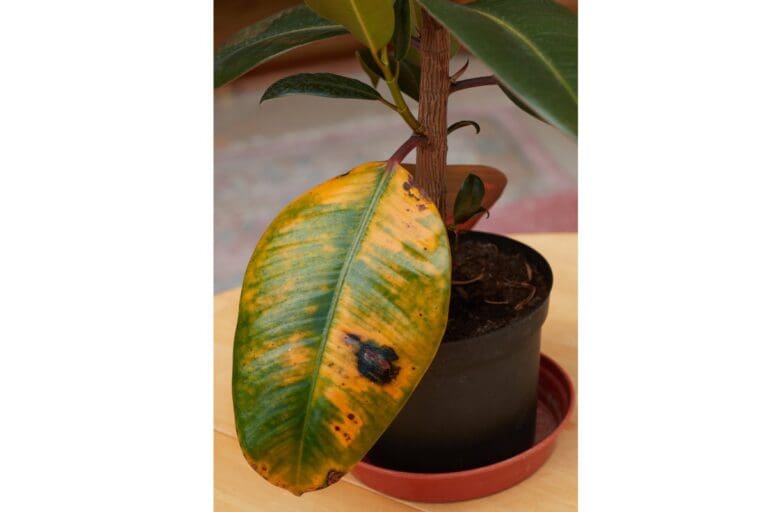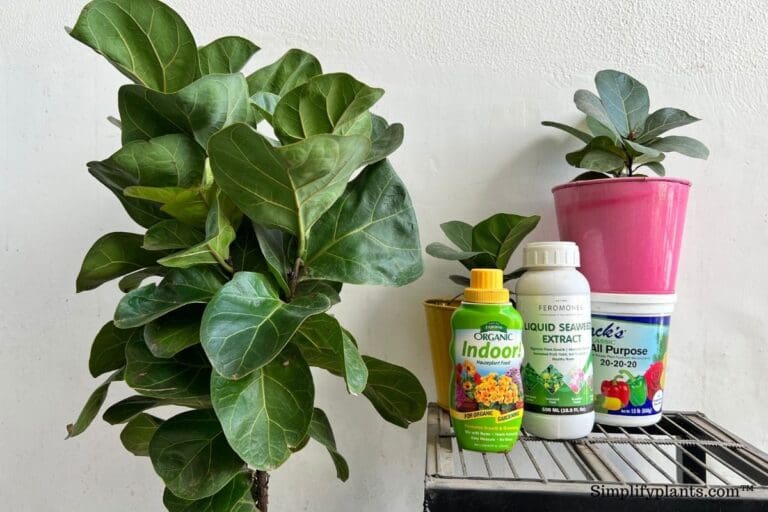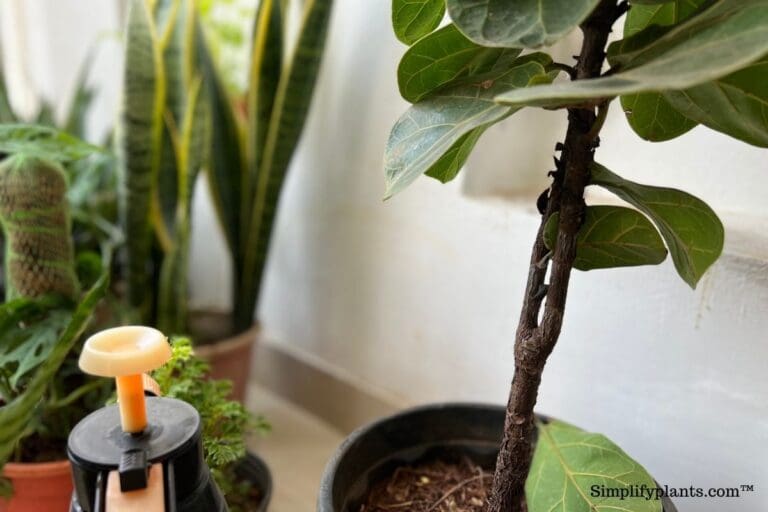Why Is My Fiddle Leaf Fig Not Growing? (+How To Fix)
Fiddle leaf fig is a favorite in the houseplant community, and the owners love it for its magnificent leaves that can make any corner of the house look alive.
You know something is wrong when the growth of the plant is significantly slow. But do you know the reason for the slow growth in your fiddle leaf fig? That is what we are going to find out in this article.
Stunted growth in fiddle leaf fig is mainly caused by flawed drainage systems, irregular watering, lack of humidity, improper lighting, and pest infestations. Therefore, providing appropriate lighting, water and nutrient should encourage new growth in fiddle leaf fig.
Other reasons might also be hindering the growth of your fiddle leaf fig. We will discuss all the causes and find out how to enhance the growth of your fiddle leaf fig.

Please note: Simplify Plants is reader-supported. Some links in the post are affiliate links and I get a commission from purchases made through links in the post.
Are fiddle leaf fig slow-growing?
Fiddle leaf figs are native to the tropical rainforests of Western Africa and can grow up to a height of 40 feet in their natural habitat.
But indoors, fiddle leaf figs are slow-growing plants and can take as much as 10-15 years to fully mature, reaching a height of 10-15 feet.
My fiddle leaf fig is not growing
Some of the most common reasons that stop a healthy growth in fiddle leaf figs are inadequate lighting and irregular watering.
It could also be that the temperature or the humidity is not ideal for the plant. Let’s take a look at all the factors.
- Irregular watering
- Inadequate lighting
- Lack of fertilizer
- Rootbound
- Incorrect potting soil
- Temperature fluctuations
- Pest infestation
- Low humidity
- Poor drainage system
- Stress
- Season
- Bacterial infection
- Suffocated leaves
Let’s understand the problems thoroughly to determine the problem with our fiddle leaf fig and fix it accordingly.
Irregular watering

Figuring out how much water your fiddle leaf fig needs can be challenging, but you should water it once a week on average.
Erratic watering often becomes a problem if you don’t maintain a proper watering schedule for your fiddle leaf fig.
Both overwatering and underwatering are caused due to inconsistent watering. And both these factors can prove to be fatal for the plant.
Overwatering

Like all the other plants, fiddle leaf figs often get overwatered, and it gets challenging to fix this problem.
Overwatering leads to root rot which is a severe issue in plants and can be extremely harmful.
If you have an overwatered plant, you will notice that the soil is wet most of the time, and the leaves are turning brown, and finally root rot.
Solution
If you already have an overwatered plant that shows symptoms, you need to reduce your watering and stick to a schedule. Watering once a week should work well for most fiddle leaf figs.
Let the soil get dry before you water the plant again. Make sure that the drainage holes are working well and the excess water is getting drained away.
In case of root rot, you need to prune the damaged roots and repot the soil in a new pot using a fresh soil mix.
Underwatering

It is said that having an underwatered plant is better than having an overwatered plant as underwatered conditions are easier to deal with.
Underwatering leads to dry and dull leaves that turn yellow and eventually fall off.
Solution
You need to increase the water supply slowly and make sure that the plant is getting enough humidity.
Also read: How often should I water my fiddle leaf fig?
Inadequate lighting

Fiddle leaf figs thrive in bright and indirect light. Light is a vital factor that helps it to photosynthesize and perform all the daily activities.
Owners often fail to understand that their fiddle leaf fig is not getting enough light. If you notice yellow leaves, thin leaves, and slow and leggy growth in your fiddle leaf fig, then you know it is not getting enough light.
Solution
Moving the plant to the brightest spot of your house that gets enough light would be ideal for your fiddle leaf fig as it needs 6-8 hours of indirect sunlight every day.
If your house doesn’t have a bright spot or a window that gets a lot of light, use artificial lights to help the fiddle leaf fig grow.
Also read: How much light do fiddle leaf fig need?
Too much light

If the fiddle leaf fig is exposed to direct and harsh sunlight for long, the plant’s leaves will get scorched.
If you notice tan and whitish spots on your leaves, you know your plant is sunburnt.
Solution
There is no way to recover the scorched leaves, so you will need to prune those and move the fiddle leaf fig to a spot that doesn’t get direct rays of the sun.
Lack of fertilizer

Fertilizing is vital for the plant’s growth. With every watering session, the nutrients of the soil get washed away.
Fertilizing helps to replenish the lost nutrients in the soil thus, helping the plant to grow.
However, if you don’t give it enough fertilizer, it becomes under-nourished and may show problems such as droopy leaves, slow growth, or yellowing or browning leaves.
Solution
Fiddle leaf figs don’t retain nutrients that they absorb from the soil, requiring fertilizers more often. Therefore, you should use a gentle fertilizer on your fiddle leaf fig once every week.
Also read: Do fiddle leaf fig need fertilizer?
Over-fertilizing

Sometimes the fiddle leaf fig owners end up feeding it extra doses of fertilizers that burn out the plants.
Over-fertilizing can bring your fiddle leaf figs problems, such as stunted growth, weak stems, and wrinkled leaves.
Solution
Wash the plant thoroughly and let it recover. After a few weeks, if the plant seems healthy again, you can start fertilizing it again.
Rootbound

Another reason for slow growth in fiddle leaf figs is that the plant has become rootbound. When the fiddle leaf figs grow fast, they end up becoming rootbound.
Since the plant roots don’t get the space to grow and spread, the overall growth of the plant becomes slow.
Other than stunted growth, you will notice symptoms such as roots coming out of the drainage holes, droopy leaves, spiraling roots at the bottom, etc.
Solution
In the case of a rootbound plant, you should repot the plant in a new pot that is larger than the current, along with fresh potting soil.
Also read: Do fiddle leaf fig like to be root bound?
Incorrect potting soil

Many houseplant enthusiasts use the same potting mix for all their plants to realize that they were using the wrong soil mix for their fiddle leaf fig.
If you are using the wrong soil, the plant will show signs such as – brown spots, drooping and falling leaves, and slow growth.
Solution
To combat this problem, you need to understand the soil requirements of your fiddle leaf fig. Then, you should prepare the correct soil mix and repot the plant using that.
Fiddle leaf figs require a well-draining soil that also provides aeration. In addition, it should be nutrient-rich and hold enough moisture for the growth of the roots.
Also read: What kind of soil do fiddle leaf fig need?
Temperature fluctuations

Fiddle leaf figs are sensitive to sudden rise or fall in temperatures. This can stress the plant and make its growth slower.
Winter months can be very harsh for the plant as the temperature starts dropping.
The ideal temperature for the fiddle leaf figs is between 60 – 75°F. Temperatures lower than 50°F are not suitable for them.
Solution
Try to provide the ideal temperature by using a humidifier that helps the fiddle leaf figs to retain some warmth during the winter months.
Don’t expose the plant to cold drafts and keep the plant away from the window during winter.
Also, ensure that you are not keeping the plant near the fireplace to increase the temperature, as keeping it too close will burn the leaves.
Pest infestation

Pests such as mealybugs, spider mites, and scales can infect your fiddle leaf fig. Pest infestation is very harmful and reduces your plant’s growth and can also be deadly for the plant.
Small holes on the leaves of your fiddle leaf fig or spiderweb-like structures under the leaves mean that the pests have attacked your plant.
Solution
You can use pesticides to keep the pests away from the plants. But if you are looking for something organic, use neem oil on your fiddle leaf fig.
Also, you can use soap water to wipe the leaves of your fiddle leaf fig, and that should also help keep the pests away.
Also read: Do fiddle leaf fig attract bugs?
Low humidity

Fiddle leaf figs are tropical plants that thrive in a humid climate. In the wild, the plants are exposed to 75-95% humidity.
Fiddle leaf figs will do well in a humidity level of 40-60%, but the humidity decreases during the winter months, contributing to the plant’s slow growth.
Solution
A humidifier helps to increase the humidity inside your home. Misting the plants also adds humidity to the plant.
Using a pebble tray will also be beneficial and increase the humidity levels for the plant.
Also read: Should I mist my fiddle leaf fig?
Poor drainage system
Fiddle leaf figs don’t like to sit on water for too long, so it is crucial to have a sound drainage system to keep the plant healthy.
Poor drainage leads to water retention that in turn causes root rot in plants. All these will eventually slow down the growth of the plant and cause many other problems.
Solution
Ensure that the pot of your fiddle leaf fig has proper drainage holes that allow the water to drain away. You should also use well-draining soil that doesn’t retain too much water.
Stress

Fiddle leaf figs love consistency. Even the slightest change can cause stress or shock the plant.
This is why it is advised that if you want to change anything for your fiddle leaf fig, do it gradually and slowly.
Transplantation can often cause stress in fiddle leaf figs. Stress can cause slow growth, falling leaves, etc.
Solution
Looking after the plant and watering it thoroughly after repotting helps reduce stress and helps the plant recover faster.
Season
Fiddle leaf figs love the warm and humid climate, and that is when the plant is most active and grows fastest.
However, the winter season doesn’t provide the ideal conditions for the growth of these plants.
Your fiddle leaf fig may not grow at all during the winter months. Don’t worry. Winter is the dormant period for these plants, and the plant rests during this time of the year.
Solution
Wait for the winter to pass away, and once the fiddle leaf fig is active, it will start growing again.
Don’t fertilize the plant during winter as the plant will not be able to use it, due to which the roots will get burnt.
Bacterial infection

Root rot often creates an environment where the fungus thrives. As a result, bacterial infections tend to be slightly different, and you can identify them if you notice the following symptoms.
In case of bacterial infections, you will notice that the leaves turn yellow, and the brown spots are spreading across the leaves.
A bacterial infection affects new leaves, and those will become yellow fast. Eventually, the leaves will fall off.
Solution
If the number of leaves affected is less than 50%, you can remove those leaves from the plant and repot them using a fresh potting mix.
Make sure that the plant is getting enough light and you are not overwatering it.
Suffocated leaves
When you leave your fiddle leaf fig in the corner of the house and don’t take much care of it, the plant’s leaves start accumulating dirt and dust.
This prevents photosynthesis and causes problems in the breathing of the plant.
Solution
The only solution is to keep the leaves clean. You can wipe the leaves with a cloth and water to make sure that it is clean.
You can also shower the plant once every few months to clean the dust off. This will also help to keep the pests away and allow the leaves to breathe.
How do you encourage fiddle leaf figs to grow?

If you want to encourage growth in your fiddle leaf fig, here are some quick tips that might not seem a lot but will show a difference in the plant’s growth.
- We have already stressed the importance of light, and the fiddle leaf figs need a lot of it. Try to provide indirect light to your fiddle leaf fig for at least 6-8 hours every day.
- Make sure that the plant is getting light on all sides by rotating it slowly once a while.
- Try to understand the water requirements of your fiddle leaf fig and create a routine and follow it. Erratic watering leads to different problems, and you don’t want that to happen.
- Start by watering the plant once a week and then adjust accordingly. Don’t let the soil get too dry. Consider watering when the soil feels cold and a little moist.
- Drainage is critical as fiddle leaf figs don’t like sitting on the water. Make sure that the pot has enough drainage holes that are letting the water drain out correctly.
- You can even place some stones at the bottom of the pot so that the soil doesn’t block the drainage holes.
- Repot the plant once every 2-3 years. The soil often becomes acidic over time and doesn’t retain enough nutrition.
- Repotting the plant with a new soil mix not only replenishes the lost nutrients but also stops the plant from being rootbound.
- Use a gentle and balanced fertilizer that has all the nutrients to help the plant grow faster.

Sources: CABI.ORG, New York Botanical garden, University of Florida.
Recommended Garden Supplies
| Product Image | Our Recommended Gardening Supplies | Check Offers! |
|---|---|---|
Top Top
Top
Top
Top
Top
Top
Top
Top | rePotme Houseplant and Tropical Classic Potting Soil Mix | Check Offer On Amazon |
 Top
Top
Top
Top
Top
Top
Top
Top | Espoma Organic Indoor Plant Food | Check Offer On Amazon |
 Top
Top
Top
Top
Top
Top
Top
Top | GooingTop LED Grow Light 6000K Full Spectrum Clip Plant Growing Lamp | Check Offer On Amazon |
 Top
Top
Top
Top
Top
Top
Top
Top | Soil Moisture Meter | Check Offer On Amazon |
 Top
Top
Top
Top
Top
Top
Top
Top | Govee Hygrometer Thermometer, Bluetooth Enabled! | Check Offer On Amazon |
 Top
Top | LEVOIT Humidifiers for Large Room(Best For Plants) | Check Offer On Amazon |
 Top
Top
Top
Top
Top
Top
Top
Top | Upgraded DIY Automatic Drip Irrigation Kit, 15 Potted Houseplants Support | Check Offer On Amazon |
 Top
Top
Top
Top
Top
Top
Top
Top | Stainless Steel Heavy Duty Gardening Tool Set | Check Offer On Amazon |
 Top
Top
Top
Top
Top
Top
Top
Top | Bonide Insecticidal Soap | Check Offer On Amazon |
 Top
Top
Top
Top
Top
Top
Top
Top | Bonide 32 oz Spray Neem Oil for Organic Gardening | Check Offer On Amazon |
 Top
Top
Top
Top
Top
Top
Top
Top | Garden Safe Fungicide | Check Offer On Amazon |






